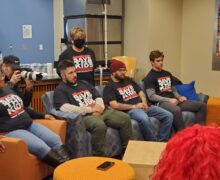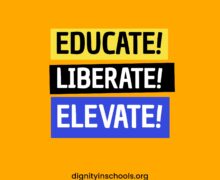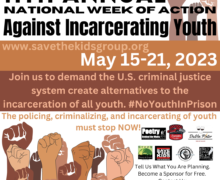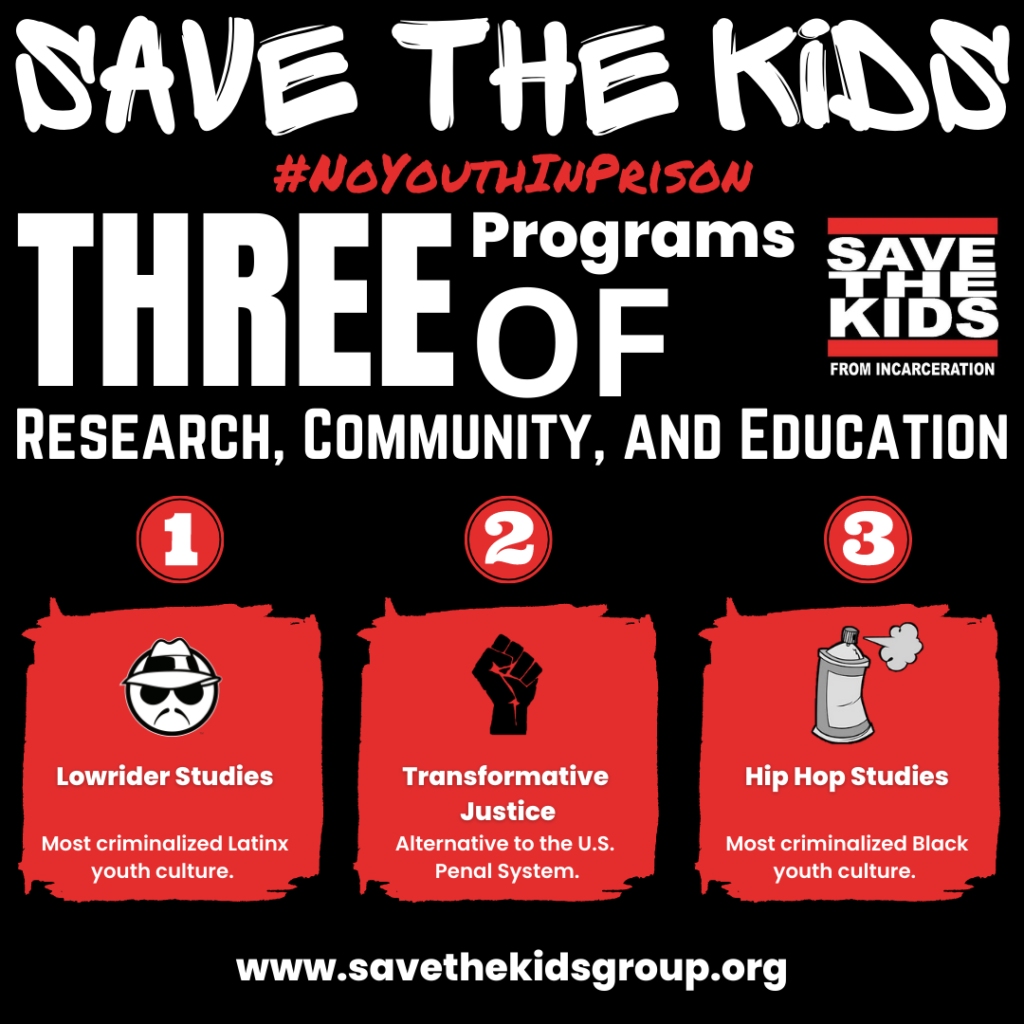6th Annual International Transformative Justice and Abolition Criminology Conference
6th Annual International Transformative Justice and Abolition Criminology Conference
____________________________________________
Salt Lake Community College
South City Campus
1575 State St, Salt Lake City, UT 84115
1pm to 6pm
1st Floor – Room 1-0130 and 1-032
February 18, 2020
Free and Open the Public
The conference will bring together teachers, researchers, activists, organizers, scholars, academics, policymakers, employees of the criminal and juvenile justice systems, people who were formerly incarcerated, and members of the public – who are working on issues related to transformative justice, decolonization, healing justice, inclusion, equity, racial justice, abolition criminology, social justice, and punitive justice abolition to discuss how we can connect our (1) research, (2) organizational efforts, and (2) social movements together to build power and develop strategy to create a world beyond punishment. We are renewing our desire to include voices of formerly or currently incarcerated community, for our lives are built upon the resistance of our ancestors and are haunted by the unchanging root sources of colonial power: the militarized occupation of stolen lands and the racialized labor that was forced to work them.
_______________________________________________________________
Sponsored by:
Department of Criminal Justice, Utah Criminology Student Association, and Save the Kids
_______________________________________________________________
6th Annual NOT 5th Annual International Transformative Justice and Abolition Criminology Conference
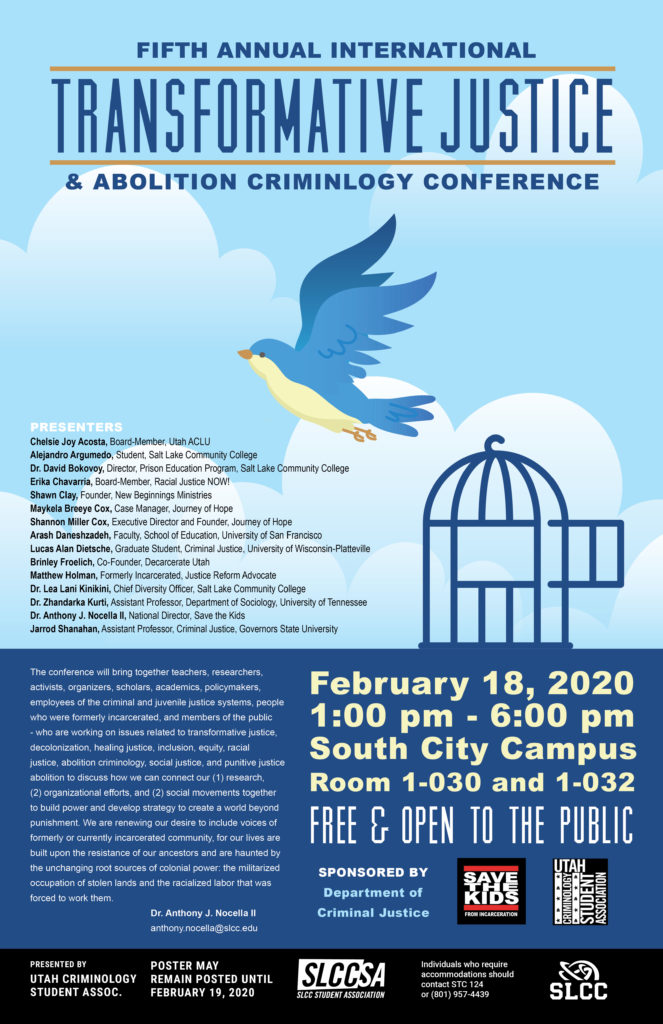
SCHEDULE
1:00pm to 2:30pm
SESSION ONE -Voices of Former Incarcerated People
1. Letters to Prisoners: A Simple, Important, and Necessary Act of Prison Abolitionist Solidarity
Lucas Alan Dietsche
Lucas Alan Dietsche is currently pursuing his Graduate Degree in Criminology/Criminal Justice at University of Wisconsin-Platteville. He is in many radical spaces including but not limited to Midwest Save the Kids, Criminal Justice Committee of the Duluth NAACP, and Socialist Resurgence. He helps send radical propaganda, books, and birthday cards as organizer of Save the Kids Letters to Prisoners Project. He is also currently an Editor of the Poetry Behind the Walls. As Former Co-Poet Laureate of Superior, Wisconsin, he has written and published many collections of poetry and novels. He has a blog called “Xennial Poetry Notes.”
_______
Letter writing is a simple important practice of solidarity. Letter writing creates the social bond that helps the incarcerated person feel part of a non-prison society. The prison abolitionist on the outside is connected to the reality of the U.S. being the largest keeper of people in prison and jail in the world. Prison pen pals can be beneficial to the inside knowledge of incarcerated life. There is a shadow of knowledge of theoretical, methodology, and the pedagogy of letter writing groups and letter writing. Depending on groups writing to common-law and/or political prisoners, there are many quantifying and qualifying variables in making sure incarcerated folks receive letters. Stamp, card, paper, address position on the body of the letter and envelope, incarcerated person status are only a few variables that make a letter writing successful to both the “in and “out” persons. Large scale discussion is needed to facilitate what works regarding content, context, and how to conceive letter writing. Complete discussion of Letter-writing groups and letter-writing methodology on many of these topics helps to organizing and streamline many misunderstandings and knowledge shadows. Hopefully national and international networks of Letters to Prisoners groups can collaborate to learn and grow.
_____
2. Reintegration
Matthew Holman
Matthew Holman is a formerly incarcerated justice reform advocate. He has worked with the Vera Institute of Justice and the Unlock Higher Ed coalition to show lawmakers in Washington, DC the power of education in the lives of incarcerated individuals. He is currently a resident of Salt Lake City, UT and volunteers with the University of Utah Prison Education Project and the Utah Reintegration Programs as an advisor, researcher, and speaker.
____
Matthew Holman served a 15-year prison sentence in the state of Utah, during which he earned an associate’s degree from Utah State University and worked as a graphic designer in the prison sign and print shops. Released in 2017, he completed a Bachelor of Science in Information Systems from the University of Utah with a 4.0 GPA in 2019, and began volunteering with the University of Utah Prison Education Project as a researcher, advisor, and designer. Knowing firsthand the transformative power of education, he has worked with groups like the Vera Institute of Justice, the Unlock Higher Ed Coalition, and others locally in Utah to promote the necessity of greater access to higher education for the incarcerated. His sentence, while long, has given him a unique perspective on love, healing, and an appreciation for the little things in life – like the beautiful views in Utah and around the world.
______
3. Define Your Divine – Reshaping the Narrative around Incarcerated Survivors
Maykela Breeye Cox
MayKela Breeye Cox is a 28-year-old, mother of one, and 4.0 University of Utah pre-law student. She was previously incarcerated in the Utah County Jail where she spent 8 months pre-trial. Facing over 15 first and second degree felonies, with 25-years-to-life minimums, a piece. MayKela is now a Case Manager at a nonprofit called Journey of Hope, where she assist harmed women, girls and marginalized men fleeing: sexual assault, domestic violence, homelessness, substance abuse, human trafficking, those fighting the obstacles of criminal backgrounds, and girls aging out of DCFS and juvenile justice services. MayKela, assists these survivors in identifying their barriers, acknowledging their traumas, and through an empowered lens – define success for themselves.
______
Most of the people incarcerated, like myself, are survivors of severe childhood trauma. Many of whom are people of color who grew up without resources and healthy examples, to assist them in navigating through their trauma. Trauma that altered their developing minds into a flight, fight, or freeze mode, forcing them to survive without healthy support systems and coping mechanisms. Children, specifically children of color, who experience uninterrupted horrific violence in adolescence, become the men and women we see in our penal systems today.
_____
4. Each 1 Teach 1
Shawn Clay
Shawn Clay grew up in Syracuse New York. He grew up in a broken home. With no father in the home nor any positive male role models in his life. His mother did the best should could but she couldn’t give him what only a good male model could give. since he couldn’t find that in the home he found it with a group that accepted him, which lead him down a path of addiction that lead him to dropping out of school in the 9th grade leaving home at 16 doing his 1st jail bid at age 18-19 in and out of jail and self medicating life long trauma with crack and meth and a life of homelessness. Shawn came to Utah in 1995 was in prison by 1997 for aggravated robbery in which nothing was taken nor attempted to but a witness said they heard him say “give me your bag” so he was charged with aggravated robbery and sent to prison on a 0-5. Today he is happily married, a Pastor and is the founder of New Beginnings Ministries a 501 c3.
_____
Shawn believes that we can save inner city youth from being drop outs, jail and gangs. if we catch things at the root and realize that locking inner city adults and children up isn’t the answer. He would like to see more inner city mentor programs that would identify inner city youth that don’t have male role models this is a big repercussion of mass incarceration and overly harsh sentences for minorities. If we can do this it could detour our youth from a life of gangs, drugs and crime. We could also apply this model to adults by having a mentor program for those that have been in crime, drugs and incarceration and mentoring those that are seeking a way out By each 1 teaching one.
____
5. Once Lost, But Now I’m Found
Alejandro Argumedo
Alejandro Argumedo is a proud father to 3 amazing kids, and a part time student at salt lake community college where he’s striving to achieve his commercial electrical journeyman license. He was previously incarcerated from the age of 21 to 26 in salt lake county jail, where he faced 3 first degrees felonies with gang enhancements, a total of 35 years to life. After fighting his case for five years he won and came home to his family and a completely different life from the one previously known. He now is a second year full time electrical apprentice and is continuing to one day become a project developer. He volunteers as a speaker with the Utah Reintegration Program and Save the Kids to give insight on the experiences of incarceration.
_____
Many inmates and such as Alejandro, grew up in broken homes without any true guidance and/or stability. As a child, one craves and seeks that guidance whether it be from someone or something , positive or negative influence. So Alejandro is a true believer that having more mentor programs with positive people to show a kid at a young age their potential and worth and properly guide them is crucial. He’s met many adults with child like tendencies , and proving this kind of system for adults as well would give many of them a foundation of positive thinking and success.
2:30pm to 4:00pm
SESSION TWO – Prison Abolition and Punitive Justice Abolition
1. What is Fueling the School to Prison Pipeline?
Chelsie Joy Acosta
Chelsie Acosta, is an educator in the Salt Lake City School District where she teaches English Language Development and Latinos In Action. She currently serves on the Utah National Association Multicultural Education (NAME) Board and the Salt Lake Education Association Executive Board. Chelsie is the National Education Association (NEA) Social Justice in Education blogger and the NEA Hispanic Caucus Secretary. In 2017, she was a finalist for the NEA Social Justice Activist Educator of the Year. Chelsie is currently a graduate student at the University of Utah in the Department of Education, Culture and Society. Her activism is centered, but not limited to; racial justice, the protection of the undocumented community, LGBTQIA+ issues and the School to Prison Pipeline. She joined the Board in 2018. Chelsie is the Save the Kids’ National Coordinator for the National Week of Action Against Incarcerating Youth and National Week Against School Pushout.
______
Erika Chavarria teaches high school Spanish in Howard County, Maryland. An advocate for racial and social justice, she became a practitioner and trainer of Restorative Justice in an effort to end the School- to-Prison Pipeline. She is currently keeps a restorative classroom. Additionally, she served on the NEA Task Force on the School-to-Prison Pipeline and School Discipline and is now a National Education Association Director representing Maryland, a Director for the Maryland State Education Association, and a Board Member of the organization Racial Justice NOW!.
_______
The School-to-Prison Pipeline primarily impacts our Black and Brown students and is a direct result of Institutional and Systemic Racism, and implicit and explicit bias. Participants will engage in critical dialogue about the educators’ roles and responsibilities in interrupting the youth pipeline to incarceration. Participants will receive a basic understanding of Restorative Justice Practices and how implementation can shift school culture and community away from punitive and zero tolerance policies and culture. We will provide examples of effective strategies that can be used to build a positive school climate and culture in schools and community. Participants will learn about various types of restorative practices that exist and their usefulness in different situations and settings, and how to seek opportunities at the local level to bring restorative practices into their schools and communities.
2. Contemporary Anarchist Criminology Book Talk
Anthony J. Nocella II
Anthony J. Nocella II, Ph.D., a scholar-activist, is an Assistant Professor in the Department of Criminal Justice and Criminology in the Institute of Public Safety at Salt Lake Community College. He is the editor of the Peace Studies Journal, Transformative Justice Journal, and co-editor of five book series including Critical Animal Studies and Theory with Lexington Books and Hip Hop Studies and Activism with Peter Lang Publishing. He is the National Director of Save the Kids and Executive Director of the Institute for Critical Animal Studies. He has published over fifty book chapters or articles and forty books. He has been interviewed by New York Times, Washington Post, Houston Chronicles, Fresno Bee, Fox, CBS, CNN, C-SPAN, and Los Angeles Times.
______
Contemporary Anarchist Criminology book offers a cutting-edge critical assessment of criminology by creating provocative discussions regarding business as usual in the criminal justice system. This exciting interdisciplinary work explores a diversity of topics that range from the construction of criminal law, to Lombroso, to deviant behavior, to prison abolition, to transformative justice, to restorative justice, to environmental justice, and to the prison industrial complex. Contemporary anarchist criminology offers a serious critique of the criminal justice system, specifically for those in sociology, political science, criminology, peace and conflict studies, and criminal justice, and is not for the timid, but for those wanting to challenge and dismantle the current forms of domination, oppression, and injustice that frame and define the current system of justice.
______
3. Carceral Non-profits and the Limits of Liberal Reform
Zhandarka Kurti and Jarrod Shanahan
Zhandarka Kurti is an assistant professor of sociology at the University of Tennessee, Knoxville. Her research and teaching focuses on mass supervision and contemporary politics of criminal justice reforms.
______
Jarrod Shanahan is an assistant professor of criminal justice at Governors State University.
______
The crisis of mass incarceration has created a political opening for social movements based on transformative justice and penal abolition. Simultaneously, well-funded “criminal justice” oriented non-profit organizations have also taken this opportunity to leverage their power by pushing for decarceration and bail reform. No matter the sincerity of these actors, decarceration on the state’s terms has failed to produce significant gains for directly-impacted communities, and has instead given way to a mutated system of punishment and social control that includes more “humane” prisons and jails, “community policing,” the expansion of community supervision, and more efficient technologies of surveillance. At the center of these transformations are what we call “carceral non-profits,” or organizations willingness to maintain or even expand the punishment system. They present a formidable challenge to abolition, not in the least because these actors often draw verbiage and tactics from abolitionism. As abolitionists and transformative justice activists this moment calls for us to need to grapple with the material and ideological function of carceral non-profits. In this presentation, we share some of our past current and future work on making sense of the historical and contemporary role that criminal justice non-profits play in foreclosing the possibility of a more radical transformation and shifting radical organizing against prisons and jails towards piecemeal liberal reform.
______
4. The Cost of Reform in Utah: The State Prison Relocation and the Inland Port
Brinley Froelich
Brinley Froelich is a writer, embroidery artist, and yoga instructor local to Salt Lake City, Utah. She is the co-founder of Decarcerate Utah, a growing prison abolitionist group focused on community education about the prison industrial complex. She started organizing around prison abolition after a visit from Angela Davis in early 2017, and established an evening yoga program for the women in the Utah State Prison that same year. She now has a monthly column at Catalyst Magazine exploring local issues around decarceration and coordinates to create local events and publications.She graduated from Brigham Young University by mistake.
________
The opposition to the inland port, of late, has stood out as a significant issue concerning Utahns. Legislatures hope to sell this project to the public as if it is in our own best interest, bringing “innovation” and “thousands of jobs” to the valley. The coinciding of the relocation of the new state prison, however, tells a different story. Discussions for relocation were prompted by lobbyists interested in profit for private corporations, including those of the lawmakers’. As plans progressed, that motivation was downplayed as public officials told constituents that this move was necessary so that inmates, staff, and volunteers could operate in better conditions.
4:00pm to 5:30pm
SESSION THREE – Transformative Justice and Healing Justice
1. Salt Lake Community College and Prison Education: A Brief History and Mission
David Bokovoy
David Bokovoy holds a doctorate in Hebrew Bible and the Ancient Near East and a Master’s degree in Jewish studies from Brandies University. He has taught at Brigham Young University, the University of Utah, and Utah State University. He is a former chaplain at Harvard University and the current Director of Prison Education for Salt Lake Community College.
_______
Founded in 2017, SLCC’s Prison Education Program (PEP) provides a model for inclusive and transformative education in the lives of incarcerated students. The program operates upon the principle of open enrollment, accepting all students above the age of eighteen who have earned either a High School diploma or a GED. For those unable to successfully perform college level work, the PEP offers non-accredited courses in Mathematics and English designed to prepare students to successfully complete their General Education credits. Through higher education, the PEP changes the way incarcerated students see themselves as individuals and as members of a larger community. The PEP offers courses that alter the trajectory of students’ lives, strengthens families that have been hurt or compromised, and enhances students’ re-entry into mainstream society. Research clearly shows that incarcerated individuals who begin or acquire a college education while in prison are much less likely to recidivate. The PEP operates according to the principle that every human being deserves education and that the community carries an ethical responsibility to ensure access to higher education within the Utah prison system.
______
2. “Words I never said”: How the Restorative Cypher can Transform the Trauma-Informed School Paradigm
Arash Daneshzadeh
Arash Daneshzadeh was born in Tehran, Iran and raised in the San Francisco Bay Area (as a biracial refugee and formerly incarcerated youth) where he has served the mission of educational equity for 16 years. Arash also serves as National Chair for Save The Kids from Incarceration, a national nonprofit focused on prison abolition and school sanctioned violence and co-edited a textbook on the topic of youth punishment entitled Understanding, Dismantling, and Disrupting the Prison-To-School Pipeline. For the past five years, Arash has taught classes on organizing movements in the Graduate School of Education at the University of San Francisco. For the past 7 years, he has taught in the Prison University Project at San Quentin State Penitentiary. Arash’s doctoral research at UC Davis involved an ethnographic study of Black girls participating in Restorative Justice programs at a local alternative school in San Francisco, which focuses on navigational and resistance capital among Black girls. Currently, Arash Daneshzadeh serves as Editor-In-Chief of The Transformative Justice Journal.
_____
Radical education theorists have long held the view that there’s a stark contrast between creating a safe space inside a teacher’s classroom and creating a politically neutral one (Gupta, A. and Ferguson, J., 1992). In this conference presentation, informed by the Black Radical Tradition (Robinson, 1983) of anti-hegemonic resistance movements and drawing from ethnographic research that centers formerly incarcerated Black girls at an alternative school, Arash Daneshzadeh will provide a new context in which project based learning (PBL) intersects with Hip Hop-centered restorative justice practices, known as the “Tier 1 Restorative Cypher”. The primary objective of this presentation is to provide educational abolitionists with tools that amplify the agency of incarcerated students in literacy education, by illustrating the nexus between Hip Hop PBL (problematizing a local inequity) and restorative justice (addressing the inequity through collective synthesis). Qualitative research is derived from a case study in the San Francisco Bay Area on Tier 1 (macrosystemic project-based learning) Restorative Practices at an alternative school serving formerly incarcerated Black girls. Arash hopes these insights will potentially spur discussion with the goal of inspiring abolitionist educators to create similar collaborations between their schools and extended communities.
______
3. Māui’s Sons: Tongan Youth and Re-Writing Youth Incarceration
Lea Lani Kinikini
Lea Lani Kinikini (PhD, University of Auckland, New Zealand, MA University of Hawaiʻi, BS University of Utah) is a researcher and educational practitioner who has worked internationally in Hawaiʻi, New Zealand, Oceania and now Salt Lake County. Her research has examined the school to prison to deportation pipeline with a focus on case law and Pacific Islander youth gangs. She has conceptualized how legal fictions are extrapolated both in the public sphere and in the legal realm to produce ranked or ‘marked’ populations underlined by racial classes. She currently is the Chief Diversity Officer at Salt Lake Community College working on building solutions to over-incarceration and is committed to creating equity through educational justice innovations.
______
Dr. Kinikini will present a session on indigenous storytelling and youth justice using the story of Māui. Using case history she will explore the moral media panic around Tongan children in Salt Lake County during the War on Gangs.
______
4. Eliminating the Sexual Assault to Prison Pipeline
Shannon Cox
Shannon Miller Cox, Executive Director and Founder of Journey of Hope, Inc. Director Cox a survivor of sexual assault herself, became a law enforcement officer to protect herself from further assault and to “arrest predators in Utah.” What she found were thousands of men and women struggling with their own histories of abuse, self-medicating with addiction, suffering in mental injury, poverty, exploitation, and incarceration. She created programs for women coming out of Utah’s Prison and Jails and then retired to create Journey of Hope. To date they have served over 1800 women, girls, and LBGTQI in this community; but there is so much work to do!
_______________
Utah is above the National Average in Sexual Assault and Domestic Violence Homicide. One in three homes in Utah is experiencing domestic violence, but in this community, we don’t talk about the epidemic of violence perpetuating the high suicide rates and opiate epidemic. We have the highest recidivism rate in the United States, 80%! Yet with a Gender-Responsive Trauma-Informed Lens, Practices, Programs, and Partners, we have 17%; when women are safe, have livable wage opportunities, and we help remove barriers from their path they are resilient and powerful!
5:30pm to 6:30pm
AWARDS AND CLOSING
________________________________________________________________


